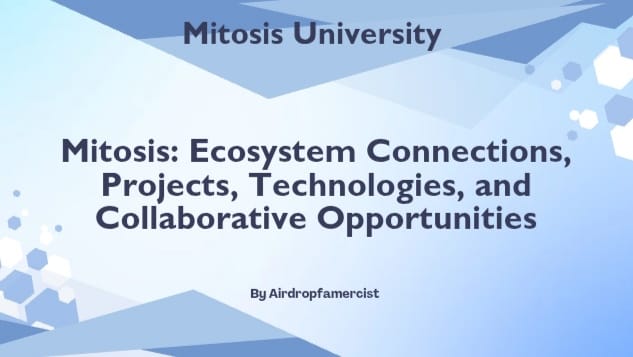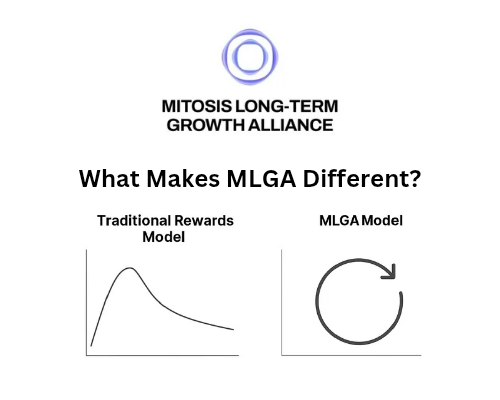Mitosis: Ecosystem Connections, Projects, Technologies, and Collaborative Opportunities.

In the rapidly evolving world of decentralized finance (DeFi), Mitosis stands out as a pioneering Layer 1 (L1) blockchain protocol designed to address one of the most pressing challenges in the multi-chain era: fragmented liquidity.
By introducing an innovative Ecosystem-Owned Liquidity (EOL) model, Mitosis is redefining how liquidity is managed, shared, and utilized across blockchain networks.
This article explores Mitosis’ ecosystem connections, the projects and technologies it relates to, and the collaborative opportunities and integrations it offers with its partners.
Understanding Mitosis: A Gateway to Programmable Liquidity
Mitosis is not just another blockchain; it is a purpose-built solution for the modular era of DeFi. At its core, Mitosis aims to unify liquidity provision across multiple blockchains, making it easier for liquidity providers (LPs) to maximize yields and for decentralized applications (dApps) to access robust liquidity pools. Its flagship innovation, Ecosystem-Owned Liquidity (EOL), allows LPs to deposit assets into Mitosis Vaults—strategically placed across various chains—where they receive miAssets, yield-bearing tokens representing their share of the protocol’s liquidity. These miAssets can then be used within the Mitosis ecosystem to unlock a range of DeFi opportunities, from lending to trading, all while maintaining composability and flexibility.
Unlike traditional cross-chain solutions that lock or burn assets, draining liquidity from original chains, Mitosis dynamically distributes assets across yield opportunities on their native networks. This approach fosters a cooperative rather than competitive dynamic with other blockchain ecosystems, revitalizing liquidity and supporting innovation. Built with Ethereum Virtual Machine (EVM) compatibility and leveraging the Cosmos SDK, Mitosis is positioned as a scalable, interoperable hub for cross-chain finance.
Ecosystem Connections: Projects and Technologies
Mitosis’ ecosystem is deeply interconnected with a variety of projects and technologies, each contributing to its vision of seamless liquidity and interoperability. Below are some of the key relationships that define its technological and operational landscape.
1. Hyperlane: Powering Cross-Chain Interoperability One of Mitosis’ cornerstone technological relationships is with Hyperlane, a permissionless interoperability layer. Hyperlane enables Mitosis to facilitate secure and efficient asset and data transfers across disparate blockchains. This partnership is critical to Mitosis’ mission of connecting chains and uniting liquidity, as it provides the messaging infrastructure needed for cross-chain communication. By integrating Hyperlane, Mitosis ensures that its vaults and L1 chain can interact seamlessly with networks like Ethereum, Arbitrum, and Optimism, enhancing user convenience and security.
2. Ether.fi: Liquid Restaking Integration Ether.fi, a prominent liquid restaking protocol, is another key player in Mitosis’ ecosystem. This relationship allows Mitosis to integrate restaked ETH security into its framework, bolstering the protocol’s ability to validate cross-chain messages and secure its Proof-of-Stake (PoS) consensus mechanism. Ether.fi’s involvement enhances Mitosis’ appeal to LPs by offering additional yield opportunities through restaking, aligning with the protocol’s goal of maximizing asset utilization.
3. Symbiotic: Collaborative Security Solutions Symbiotic, a protocol focused on modular security solutions, complements Mitosis by providing flexible security mechanisms that scale with total value locked (TVL). As Mitosis grows, Symbiotic’s crypto-economic security model ensures that the protocol remains robust and trustworthy. This partnership underscores Mitosis’ commitment to building a secure foundation for its liquidity collective, making it an attractive platform for both LPs and dApp developers.
4. Integrated Blockchain Networks Mitosis has successfully expanded its reach by integrating with multiple blockchain networks, including Ethereum, Arbitrum, Scroll, Mode, Blast, Linea, Optimism, and Manta. These integrations broaden Mitosis’ utility, allowing it to serve as a liquidity hub for a diverse range of ecosystems. For instance, its support for weETH (wrapped Ether from Ether.fi) on Layer 2 (L2) solutions demonstrates how Mitosis can bootstrap liquidity across networks, making assets more accessible and usable for dApps.
5. Theo Network: Institutional-Grade Strategies A notable project-level connection is Mitosis’ partnership with Theo Network, announced in early 2025. Theo Network integrates with Mitosis Matrix Vaults to bring institutional-grade, delta-neutral strategies to liquidity suppliers. This collaboration exemplifies how Mitosis can cater to sophisticated investors, offering structured products that balance risk and reward within its ecosystem.
Collaborative Opportunities with Partner Protocols
Mitosis’ design as a cooperative liquidity protocol opens the door to a wealth of collaborative opportunities with partner protocols. By fostering mutually beneficial relationships, Mitosis not only enhances its own ecosystem but also supports the growth and adaptation of connected chains and dApps in the multi-chain era.
1. Liquidity Bootstrapping for Modular Blockchains One of Mitosis’ primary value propositions is its ability to attract Total Value Locked (TVL) to newly constructed modular blockchains. Through its EOL architecture, Mitosis enables these networks to leverage community-owned liquidity, reducing their reliance on opaque private transactions with major LPs. Partner protocols can collaborate with Mitosis to establish vaults, drawing in LPs with the promise of multi-chain yield exposure. This process is governed transparently via forum discussions and initiation votes, ensuring fairness and alignment with ecosystem goals.
2. Integration with DeFi Applications Mitosis’ miAssets and maAssets (tokenized programmable liquidity) offer dApp developers a powerful tool for building advanced DeFi strategies. Partner protocols can integrate with Mitosis L1 to tap into pre-established liquidity pools, eliminating the need to onboard individual LPs manually. For example, a lending protocol could use miAssets to offer cross-chain borrowing options, while a decentralized exchange (DEX) could leverage maAssets to enhance trading liquidity. These integrations create a symbiotic relationship where dApps gain access to liquidity, and Mitosis benefits from increased asset utilization.
3. Co-Marketing and User Acquisition Campaigns Mitosis’ Expedition program, which has attracted over 200,000 beta testers and accumulated $100 million in TVL as of April 2024, highlights the potential for collaborative marketing efforts. Partner protocols can join forces with Mitosis to launch joint campaigns, such as incentivized deposit programs or governance token airdrops (e.g., converting MITO Points into tokens). These initiatives drive user engagement and expand the reach of both Mitosis and its partners, creating a win-win scenario.
4. Cross-Chain Yield Optimization Mitosis’ ability to unify yields across distinct chains presents a unique opportunity for partner protocols specializing in yield farming or asset management. By integrating with Mitosis Vaults, these protocols can offer LPs exposure to a diversified portfolio of yields without the complexity of managing multiple networks. This collaboration simplifies decision-making for retail LPs, who often feel overwhelmed by the sheer number of options in DeFi, and strengthens the value proposition of both Mitosis and its partners.
5. Governance and Ecosystem Development Mitosis’ governance system, which dynamically allocates liquidity based on market sentiment, invites collaboration from partner protocols interested in shaping the ecosystem’s direction. Protocols can propose new vaults or strategies, participate in governance votes, and contribute to the development of Mitosis L1 applications. This participatory model fosters a sense of ownership among partners, aligning their interests with Mitosis’ long-term success.
The Broader Impact of Mitosis’ Ecosystem Connections
Mitosis’ relationships with projects, technologies, and partner protocols are not just technical integrations—they represent a paradigm shift in how liquidity is perceived and managed in DeFi. By transforming passive liquidity into a dynamic, market-responsive force, Mitosis empowers LPs to contribute to ecosystem growth while retaining control over their assets. Its partnerships with Hyperlane, Ether.fi, and Symbiotic ensure that this vision is executed with cutting-edge interoperability and security, while connections with networks like Arbitrum and Optimism expand its practical reach.
For dApp builders, Mitosis eliminates traditional barriers to liquidity procurement, offering a pre-existing pool of assets ready for innovative use cases. For blockchain ecosystems, Mitosis provides a lifeline to revitalize stagnant liquidity, supporting their transition to the multi-chain era. And for LPs, Mitosis delivers a seamless, rewarding experience that transcends the limitations of single-chain DeFi.
The Future of Mitosis’ Ecosystem
As Mitosis continues to grow—backed by over $7 million in seed funding from top-tier investors like Foresight Ventures and Amber Group—its ecosystem connections will only deepen. The protocol’s roadmap includes further integrations with L2 rollups, enhanced DeFi applications on Mitosis L1, and expanded partnerships with institutional players like Theo Network. With its focus on collaboration rather than competition, Mitosis is well-positioned to become a central hub in the modular DeFi landscape.
In conclusion, Mitosis’ ecosystem connections with projects, technologies, and partner protocols illustrate its transformative potential. By bridging liquidity across chains, fostering collaborative opportunities, and integrating with cutting-edge solutions, Mitosis is not only solving fragmentation in Web3 but also paving the way for a more interconnected, efficient, and inclusive DeFi future.
As the protocol evolves, its relationships will undoubtedly continue to shape the next generation of decentralized finance, proving that in the multi-chain era, cooperation is the key to success.

Comments ()